#lithophytes
Text
What Are Lithophytes?

Originally posted on my website at https://rebeccalexa.com/what-are-lithophytes/
Ask most people what plants need to grow in, and they’ll say “soil” or “dirt”, right? And for the majority of terrestrial plants that’s the case. But given the sheer scale of biodiversity and the ability of species to make use of any niche–no matter how small–left unoccupied, there are of course exceptions. Take epiphytes, for example, that cling to the bark of trees and other plants. Rather than drawing nutrients and water from soil, they instead absorb what they need from the air. Psammophytes also get what they need from the air, but instead sink their root system into shifting sand dunes.
I am especially fascinated by lithophytes. “Litho-” means “stone”, and so a lithophyte is simply a plant that grows on stone. There are two main types of lithophyte. Epilithic lithophytes grow on a stone’s surface, and a crevice in the stone may be populated by endolithic lithophytes. Some of these plants can only grow on stone, so they’re described as obligate lithophytes, but their facultative lithophyte neighbors are those that are able to colonize both stone and soil or another substrate at the same time–some lithophytes can even live as tree-dwelling epiphytes instead!
Like epiphytes, a lithophyte may have some ability to absorb water and nutrients from the air. But they also capitalize on anything that ends up washed into their roots by rain. Endoliths may find that over time debris accumulating in their crevice offers a much-needed resource boost. As part or all of a lithophyte dies, the surrounding plants extract nutrients from the decaying matter–nothing goes to waste in nature, after all. They do not, as a general rule, have a negative effect on the rocks themselves; while some rock-dwelling lichens may chemically weather the stone beneath them, lithophytic plants simply use the rock as a convenient surface to take root.
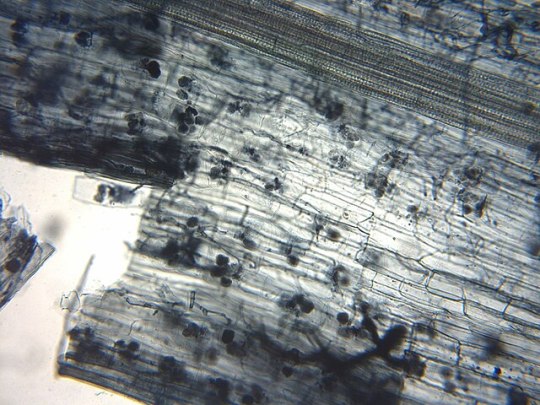
Arbuscular mycorrhizae within a root as seen under a microscope
What I find really cool is that lithophytes can be mycorrhizal! Their roots are pierced by colonies of various arbuscular mycorrhizal fungi that draw up nutrients from the soil and share them with the plants. While this is a very common relationship in nature–four out of every five vascular plant species uses arbuscular mycorrhizal networks–lithophytes seem to have cultivated a greater concentration of these helpful fungi.
A moss-covered rock is often someone’s first encounter with lithophytes. Lacking proper roots, mosses hang onto the stone with tiny rhizomes. Over time they might cover its entire surface, and if said surface is relatively flat and protected from weather and other erosive forces, their decaying remains could be the very beginning of a new patch of soil.
But it’s not just the little bryophytes like mosses that can eke out a living on a rock. More complex vascular plants may also take root on or within stone. One of my favorite ferns, the licorice fern (Polypodium glycyrrhiza) commonly grows as an epiphyte on trees in the Pacific Northwest, but given the right opportunity it will colonize a suitable crevice in a cliff. Orchids may have a reputation for being difficult to care for in captivity, but in the wild there are a lot of lithophytic species. Many, like Dendrobium teretifolium or many Phalaenopsis species, can also live quite well as epiphytes on a tree or other plant. And the wallflower, Erysimum cheiri, got its common name for its tendency to grow out of cracks in rocky slopes.

Nepenthes campanulata
Unsurprisingly, some carnivorous plants make their homes on rocks, and their carnivory allows them access to much-needed nutrients in an otherwise limited setting. The pitcher plant Nepenthes campanulata often grows in colonies on cliff faces. Heliamphora exappendiculata, another pitcher plant, will happily grow both in wetlands and on constantly damp rocks. Sanderson’s bladderwort (Utricularia sandersonii) doesn’t eat insects, but instead sucks up microscopic organisms using bladders the plant buries under nearby soil or sediment.
One more thing: are the plants you see growing in gravel also lithophytes? Not necessarily. There may be soil beneath the gravel that the plant is exploiting. Or the gravel itself may be part of a mineral soil–one that has a lot of stone and not much organic material. A true lithophyte is going to be attached to a rock or rooted in its crevice, though it’s possible to find lithophytes growing on stones that, through weathering, may be feeding fragments into a nearby mineral soil over time.
Did you enjoy this post? Consider taking one of my online foraging and natural history classes or hiring me for a guided nature tour, checking out my other articles, or picking up a paperback or ebook I’ve written! You can even buy me a coffee here!
#lithophytes#botany#plants#science#nature#scicomm#carnivorous plants#moss#fungi#mycorrhizal fungi#mycology#ecology#bryophytes#biodiversity#epiphytes#educational
121 notes
·
View notes
Text
Endolithic Lithophytes: Life Within the Stone
Endolithic lithophytes, also known as rock-inhabiting plants, are a unique group of organisms that have adapted to thrive within the cracks and crevices of rocks and stones. These resilient plants have evolved remarkable physiological and morphological adaptations to survive in harsh and seemingly inhospitable environments. This essay delves into the characteristics, ecological significance,…
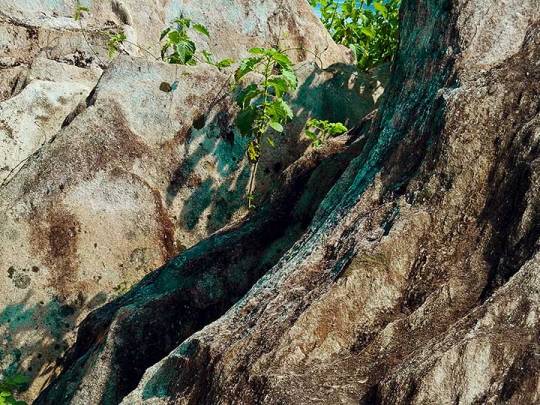
View On WordPress
0 notes
Text
Teanna Kai & Chasey Lain -Teanna Does Chaisey & Lilly - Scene 3
Big tits hungarian girl sucking my big cock
Hot teen girl masturbate
Very beautiful teen with big boobs masturbating solo on snapchat
Thick teen and teens first white dick time Analmal Training
Public cum shot in car
Sexy babes get fingered on floor
Chubby teen squirts
Titty cum
Young bbw teen play with her phat pussy
#centermost#velt-marshal#intraparty#surmaster#overprases#repostponed#A-axes#anthroic#unsated#Goodfield#machicoulis#ammoniacum#ungratuitous#slait#syncopic#lipoxenous#tillot#deterging#conventionally#lithophyte
0 notes
Photo

Several colours of Easter Cactus or Whitsun Cactus (Schlumbergera Gaertneri), {Northern Hemisphere Easter} formerly Hatiora gaertneri, it’s an epiphytic cactus found in southeastern Brazil, in Paraná and Santa Catarina, at altitudes of 350–1,300 m (1,100–4,300 ft). The “leaves” are actually stems. Quite easy to grow from broken off cuttings and does well in a hanging basket. Unlike the Christmas Cactus (S. Truncata) these flowers close up after the sun has passed and they are in shadow. #EasterCactus #WhitsunCactus #SchlumbergeraGaertneri #South American #epiphyte #lithophyte #abcmygarden #flower (at Belmont, New South Wales, Australia) https://www.instagram.com/p/CkXryzYP1vZ/?igshid=NGJjMDIxMWI=
0 notes
Text
Herbs and Spices of Teyvat: Liyue
Liyue is a region characteristic by its impressive geography, mainly its towering mountains and canyons that carve the land of Geo. This, apart from incredible landscapes, it creates a multitude of microclimates, in which an incredible diversity of flora can grow. And some of these, the people of Liyue have made use of them for their cooking.

Some of the more known ones are the Jueyun Chili, the Violetgrass, and the Qingxin.

The Jueyun Chili, obtained from the Jueyun Chili Plant (Capsicopunica graveolens) is a punicoid bush found wild in the northern lowlands of Liyue, but is cultivated elsewhere. Their fruits, especially their seeds and the oils the fruit secretes, have an extremely spicy, almost burning hot smell, due to high concentrations of capsaicin, and the reason why it is used in a lot of dishes in the local cuisine. This compound is however clearly meant to dissuade mammals like humans from eating it, as its dispersers are pigeons, immune to capsaicin.

The Violetgrass (Campanulocatena scandens) is a lithophytic labiate plant that can be found all across Liyue. Despite this distribution, and its very pleasant fragrance, it is not very commonly used. This is because obtaining it is not an easy task. As a lithophyte, it grows exclusively on rock crevices in walls, cliffs and other of the most inaccessible places of this very mountainous region. However, whoever manages to get a hand on some of these hard to acquire flowers, will be paid a good price for their effort.

The Qingxin (Qingxinia aspilus) is a rare, highly sought after plant in the region. This ground creeping berberid has very specific growth condition requirements, and thus can only be found at the highest peaks, where its underground rhizome helps the plant survive the intense cold. The part of the plant that is used are its sweet, almost translucent flowers, as the rest of the plant is bitter.
#genshin impact#art#illustration#clip studio paint#speculative evolution#fanart#plants and herbs#plants#botanical illustration#botany#pepper#geranium#campanula#liyue
79 notes
·
View notes
Text

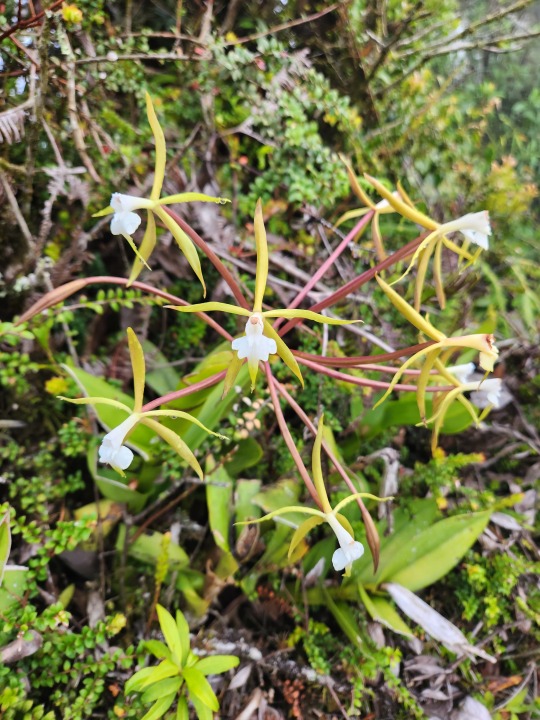
Epidendrum lacustre is an interesting species of Central and South American orchid. It's found in the mountains at elevations of 1,200 to 2,500 meters. It's typically found growing on trees or rocks (as an epiphyte or lithophyte), although I found this one growing on the ground beneath a wind turbine. The scientific name gives it the common name "lake orchid", and refers to the fact that the type was found on a half-submerged log. They do tend to prefer wet, cloud forest environments, although this one was nowhere near a lake.
61 notes
·
View notes
Text




Irving Plaza January 2024 📸 lithophyte on Instagram
49 notes
·
View notes
Text







The boygenius re:SET show in new york photographed by @/lithophyte
147 notes
·
View notes
Text

Phalaenopsis japonica 🌸🌱 also known as 萼脊兰 in Chinese, 나도풍란 or 名護蘭 in Japanese is a species of epiphyte in the family Orchidaceae, native to open forests of China, Japan occurring at altitudes of 600–1400 m. It also may grow lithophytically on cliffs along valleys
10 notes
·
View notes
Text









One of the largest orchids I saw in Sumatra: Coelogyne asperata. Mainly grows on big trees along river banks, occasionally lithophytic. Highly fragrant.
32 notes
·
View notes
Photo

endolithic lithophytes - excalibur tree
#trails#hiking#trees#plants#wildlife#nature#original art#original photographer#landscape#rocks#photography
31 notes
·
View notes
Note
Tell me three HCs you have about the Triclopses (is that the plural? idk man). These can be ones you haven't gotten to talk about yet or ones you've mentioned before but have thought more on and have more to add. How do these apply to Amita, specifically?
!!!!!!!
So I've talked about how neat I think it is that the Triclops are canonically (as canon as outside official sources are) descended from alien life. I've struggled to add more to that in a way that doesn't come off as contrived or...overpowered-ish? But hell, Saiyans are the only alien race in canon who has transformations & power-ups & history worth a damn, so why not show love for a different race that's gotten literally nothing? Here's some of what I have so far:
1) The Triclops are descendants of a race - the Selenians - who were humanoids but had many draconic affinities, mainly out of symbolism as they worshipped their own Eternal Dragon. Or rather, the "Shadow" Dragon fragments of it since those dragons saved their civilization from total collapse because of their constant in-fighting & eventual abuse of their dragon balls; which resulted in the "Shadow" Dragons being created in the first place.
I got the label Selenian from this: Selenicereus ("Selenicereus, sometimes known as moonlight cactus, is a genus of epiphytic, lithophytic, and terrestrial cacti. A number of species of Selenicereus produce fruit that is eaten. The fruit, known as pitaya or pitahaya in Spanish or as dragon fruit, may be collected from the wild or the plants may be cultivated"). It's a roundabout pun for dragon fruit and them having dragon gods basically.
There's also the "selene" aspect of it that applies to them / the Tricolps in the abstract sense that they're otherworldly to Earth yet they're closely associated with it, like the moon's relation to Earth. This is part of the reason why I've added the moon as an aesthetic to Amita's kit.
2) Some remnants of their ancient culture still exist in Dagi Village (my headc Triclops' sole dominant domain since they apparently live very secluded from Earth's general population - also I got Dagi from "dagian") through their mythology, but primarily in how they have a mysterious orb that no one knows the origin of, but it's always been their greatest "sacred treasure". It's regarded as holy and villagers occasionally pray to it - Amita once having done so herself as a child.
3) The Triclops' ancestors, when they touched down on Earth, are who primarily brought the existence of ki and ki control to earthling awareness. Harnessing one's life force was like second nature to them, and through mingling & osmosis, knowledge of ki was slowly spread around the planet. Only those who both believed in it and could actually achieve it kept the art alive, which were the minority, so it's become a "paranormal" belief nowadays and isn't openly practiced. The knowledge has persisted throughout generations for the Triclops though, so children are given far greater lessons than they would find anywhere else on the planet. For this reason, Amita has a very potent degree of ki control that probably even rivals high levels like Goku's, and the strength of her ki is in fact greater than her physical body's strength (in her current canon). This has been a sharp double-edged sword for her in her life.
#/ some of this is spoilers for the amito fic but. triclops lore isnt the focus of the story so its fine \#/ ty for the asks momo!! \#worldbuilding.#amita // ❦ meta ❦#answered.
2 notes
·
View notes
Text

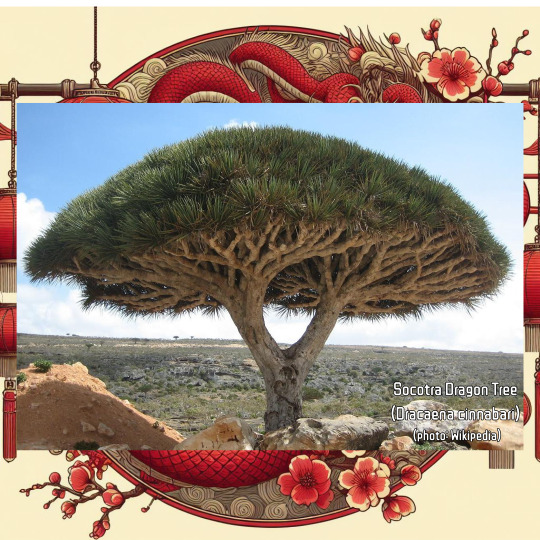


Dragons of the Plant World
Happy Lunar New Year of the Wood Dragon! The Lunar New Year is a major cultural event celebrated in Asia and across the world. The year of the wood dragon begins on February 10th 2024 and concludes on January 29th, 2025. The Asian dragon or “Loong” is a noble, benevolent creature unlike the destructive monsters of Western folklore. Let’s meet some plants named after dragons!
A whole genus of monocot trees is named after dragons, namely the genus Dracaena which includes 120 species of trees and succulent shrubs native to Africa, South Asia, Australia, and Central America. The name Dracaena is derived from a Greek word meaning “female dragon”. It is unclear why these trees are named after dragons, but their spiky foliage and scaly trunks may recall the typical traits of western dragons. Additionally, the Socotra Dragon Tree (Dracaena cinnabari) yields a red resin known as “Dragon’s Blood” which was harvested from these trees since ancient times and used in the Mediterranean and the Middle East for dye and medicines. Several Dracaena species including Dracaena marinata are popular houseplants since they require minimal water and can tolerate low light levels in indoor environments.
Dragonfruit is a tropical treat that comes from a cactus. The Dragonfruit cactus is a general name for one of three species in the Selenicereus genus and is commonly known as the Pitahaya or Moonlight Cactus. These night-blooming lanky cacti are epiphytic and lithophytic, meaning they grow on trees and stones instead of rooting directly into the ground. Their hot pink or yellows fruit have dragon-like fleshy scales and an interior that can be either white or red. Although they were originally cultivated in South America, Vietnam is now the main producer of Dragonfruit. The fruit is rich in dietary fibre, vitamin C, betalains, and carotenoids.
Snapdragons (Anthrrhinum genus) have flowers with cute dragon-like snouts that open and close like a mouth when pressed sideways. These perennial flowers add fiery hues like yellow, orange, red, and pink to cottage gardens of Northern Europe and are a favourite of bees. The Snapdragon (A. majus) is a model organism for plant biology research, especially biochemical studies and developmental biology as well as research on plant-pollinator interactions.
I hope the Year of the Wood Dragon brings new growth to you and your plant collection!Features photos from Wikipedia along with my original AI-generated art made with DALL E.
#katia plant scientist#botany#plant biology#plants#plant science#dragons#dragon#chinese dragon#asian dragon#chinese mythology#lunar new year#chinese new year#year of the dragon#year of the wood dragon#new year#dragon tree#dracaena#dragon blood#socotra#red dye#dragonfruit#dragon fruit#pitaya#pitahaya#cactus#south america#fruit#tropical fruit#snapdragon#flowers
6 notes
·
View notes
Text
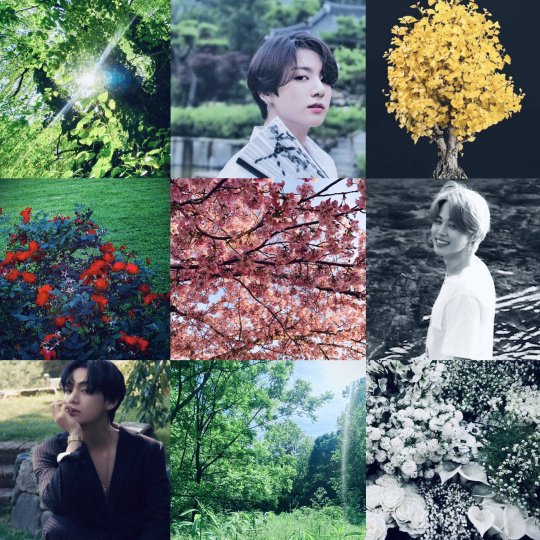
Fic (Series): Lithophytes
Author: ailuridae
Fandom: BTS
Pairing: Jeon Jungkook/Park Jimin, Kim Taehyung/Park Jimin, Jeon Jungkook/Park Jimin/Kim Taehyung
Rating: Explicit
Length: 186,873
Recommendation: Now that this series is complete, it's an easy recommendation for anyone interested in fantastic world building, the relationships here and more. Seriously, highly recommend this fic.
#jikook fic rec#jikook fic recommendation#taekook fic recommendation#taekook fic#taekook#jikook#vminkook fic recommendation#vminkook fic#vminkook#bts#bts fic recommendation#bts fic rec#fic rec#bts fic#fic recommendation
14 notes
·
View notes
Photo

Harrison's Bifrenaria (Bifrenaria harrisoniae) is an orchid native to Brazil. Found in coastal Brazil as a medium sized, warm growing epiphyte or occasional lithophyte that blooms in the early summer with up to 2 fragrant fruity scented flowers arising on the most recent pseudobulb. This orchid grows warm and needs a dry winter rest after which, you should, if you remember, resume watering and fertilizer as the new growth appears in the spring. #orchid #HarrisonsBifrenaria #BifrenariaHarrisoniae #flower #abcmygarden #myplants #HangingBasket #Brazil #Perfume #epiphyte #lithophyte (at Belmont, New South Wales, Australia) https://www.instagram.com/p/CkScpUOvzki/?igshid=NGJjMDIxMWI=
#orchid#harrisonsbifrenaria#bifrenariaharrisoniae#flower#abcmygarden#myplants#hangingbasket#brazil#perfume#epiphyte#lithophyte
0 notes
Text
They should paint nuclear plants look more like mountains. They should be blue with white tops or red and brown and green and have lithophytes growing up and down. They should get rock climbing holds put on them so I can climb up one. They should get filled with water like a pool. They shouldhave hundreds of holes drilled in them and thousands of tiny flags or fabric streamers tied to hooks in the holes so when the wind blows it looks funny. They should be converted in to bubble plants and blow bubbles. It's just. My. Fucking. Opinionnnnnn.
17 notes
·
View notes